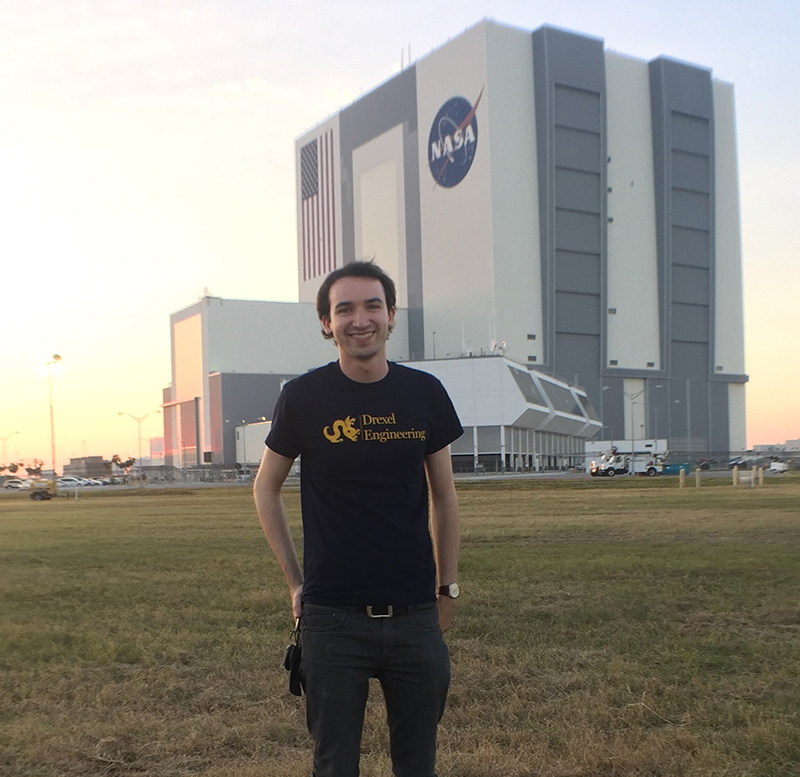By Lini S. Kadaba
 As the sun was setting, Matthew C. Wiese ’18 was holding his breath as he waited with others at Kennedy Space Center in Cape Canaveral in November [2016]. Would the weather satellite he played a part in bringing to launch be a go—or scrubbed at the last second?
As the sun was setting, Matthew C. Wiese ’18 was holding his breath as he waited with others at Kennedy Space Center in Cape Canaveral in November [2016]. Would the weather satellite he played a part in bringing to launch be a go—or scrubbed at the last second?
Wiese, a mechanical engineering B.S./M.S. junior, had spent a six-month co-op last year [2016] at NASA’s Goddard Space Flight Center research lab in Greenbelt, Md., helping to design ground-support equipment for the mouthful Geostationary Operational Environmental Satellite-16 in the R-series (GOES-16). The spacecraft is the first of four new National Oceanographic and Atmospheric Administration (NOAA) satellites that will capture information better than previous iterations and help meteorologists pinpoint severe weather more accurately, according to the agency. The goal is to ultimately save lives.
“It’s a huge upgrade,” says the 22-year-old from Voorhees, N.J. “One of the main instruments that people are excited about—well, meteorologists are really excited about—is the ABI, the Advanced Baseline Imager. That’s what takes those really beautiful pictures from space they put up on the Weather Channel of a hurricane from a bird’s eye view.”
Over the co-op, Wiese focused on the design and test of the Gaseous Nitrogen Purge System, which protects sensitive components of the satellite from dust or corrosive humidity during transport. “I got to do hands-on tests and develop all these different panels that would regulate high pressure nitrogen bottles,” says the president of Drexel University’s American Society of Mechanical Engineers.
One of his points of pride was creating detailed mechanical drawings and using a 3-D modeling program to develop panels. He also got to travel to Colorado, where the satellite was built, to work on the installation of the purge system.
In mid-November, that work came to fruition. Wiese traveled from Drexel to Cape Canaveral for the can’t-miss, Nov. 19 launch. (Check out this video of his journey.) Finally, the big moment was upon him. But command center was concerned about a booster problem. Finally, as the narrow launch window was about to close, he heard the magic words: … three… two…one…. Lift-off!
The sun was setting, which limited the view to not much more than a glowing ball of light to those on land. But Wiese was nonetheless excited. “It was cool to be able to say I helped design and validate this launch-sensitive, ground-support equipment,” he says. “It’s cool to say you have a hand in that launch process.”
Wiese never expected to find his passion in aerospace. But after his first co-op with the Army Research Laboratory in Maryland that involved sensor experiments on a NASA-contracted entry vehicle, he was well-prepared for the job at the Goddard lab. Next up, he says, is a gig with the Naval Research Laboratory, in Washington DC, on another satellite project.
No surprise, though, is his interest in engineering—and Drexel. His father, Raymond Wiese ’80, graduated with a B.S. in commerce and engineering as well as his sister Meredith Wiese Rodriguez ’13, who got her undergraduate degree in business administration, finance.
Growing up, the would-be mechanical engineer spent time in the garage with his dad, who had a handyman business, “making things and designing things. That’s what I did for fun.”
Now, Wiese gets to have a blast doing the same for co-op.